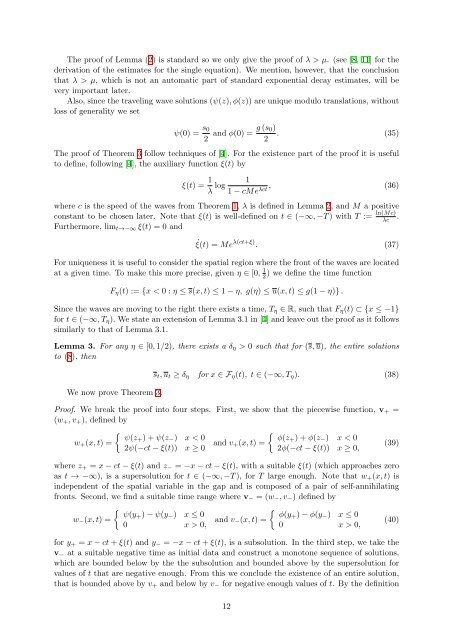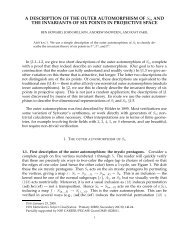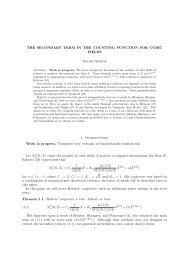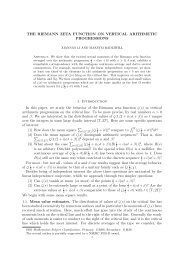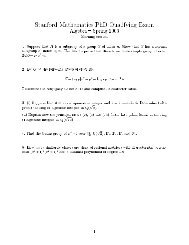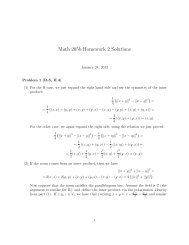Traveling Wave Solutions in a Reaction-Diffusion Model for Criminal ...
Traveling Wave Solutions in a Reaction-Diffusion Model for Criminal ...
Traveling Wave Solutions in a Reaction-Diffusion Model for Criminal ...
Create successful ePaper yourself
Turn your PDF publications into a flip-book with our unique Google optimized e-Paper software.
The proof of Lemma (2) is standard so we only give the proof of λ > µ. (see [8, 11] <strong>for</strong> the<br />
derivation of the estimates <strong>for</strong> the s<strong>in</strong>gle equation). We mention, however, that the conclusion<br />
that λ > µ, which is not an automatic part of standard exponential decay estimates, will be<br />
very important later.<br />
Also, s<strong>in</strong>ce the travel<strong>in</strong>g wave solutions (ψ(z), φ(z)) are unique modulo translations, without<br />
loss of generality we set<br />
ψ(0) = s0<br />
2<br />
g (s0)<br />
and φ(0) = . (35)<br />
2<br />
The proof of Theorem 3 follow techniques of [4]. For the existence part of the proof it is useful<br />
to def<strong>in</strong>e, follow<strong>in</strong>g [4], the auxiliary function ξ(t) by<br />
ξ(t) = 1<br />
λ log<br />
1<br />
, (36)<br />
1 − cMeλct where c is the speed of the waves from Theorem 1, λ is def<strong>in</strong>ed <strong>in</strong> Lemma 2, and M a positive<br />
constant to be chosen later. Note that ξ(t) is well-def<strong>in</strong>ed on t ∈ (−∞, −T ) with T := ln(Mc)<br />
λc .<br />
Furthermore, limt→−∞ ξ(t) = 0 and<br />
˙ξ(t) = Me λ(ct+ξ) . (37)<br />
For uniqueness it is useful to consider the spatial region where the front of the waves are located<br />
at a given time. To make this more precise, given η ∈ [0, 1<br />
2 ) we def<strong>in</strong>e the time function<br />
Fη(t) := {x < 0 : η ≤ s(x, t) ≤ 1 − η, g(η) ≤ u(x, t) ≤ g(1 − η)} .<br />
S<strong>in</strong>ce the waves are mov<strong>in</strong>g to the right there exists a time, Tη ∈ R, such that Fη(t) ⊂ {x ≤ −1}<br />
<strong>for</strong> t ∈ (−∞, Tη). We state an extension of Lemma 3.1 <strong>in</strong> [4] and leave out the proof as it follows<br />
similarly to that of Lemma 3.1.<br />
Lemma 3. For any η ∈ [0, 1/2), there exists a δη > 0 such that <strong>for</strong> (s, u), the entire solutions<br />
to (8), then<br />
We now prove Theorem 3.<br />
st, ut ≥ δη <strong>for</strong> x ∈ Fη(t), t ∈ (−∞, Tη). (38)<br />
Proof. We break the proof <strong>in</strong>to four steps. First, we show that the piecewise function, v+ =<br />
(w+, v+), def<strong>in</strong>ed by<br />
<br />
ψ(z+) + ψ(z−) x < 0<br />
φ(z+) + φ(z−) x < 0<br />
w+(x, t) =<br />
and v+(x, t) =<br />
(39)<br />
2ψ(−ct − ξ(t)) x ≥ 0<br />
2φ(−ct − ξ(t)) x ≥ 0,<br />
where z+ = x − ct − ξ(t) and z− = −x − ct − ξ(t), with a suitable ξ(t) (which approaches zero<br />
as t → −∞), is a supersolution <strong>for</strong> t ∈ (−∞, −T ), <strong>for</strong> T large enough. Note that w+(x, t) is<br />
<strong>in</strong>dependent of the spatial variable <strong>in</strong> the gap and is composed of a pair of self-annihilat<strong>in</strong>g<br />
fronts. Second, we f<strong>in</strong>d a suitable time range where v− = (w−, v−) def<strong>in</strong>ed by<br />
w−(x, t) =<br />
ψ(y+) − ψ(y−) x ≤ 0<br />
0 x > 0,<br />
and v−(x, t) =<br />
φ(y+) − φ(y−) x ≤ 0<br />
0 x > 0,<br />
<strong>for</strong> y+ = x − ct + ξ(t) and y− = −x − ct + ξ(t), is a subsolution. In the third step, we take the<br />
v− at a suitable negative time as <strong>in</strong>itial data and construct a monotone sequence of solutions,<br />
which are bounded below by the the subsolution and bounded above by the supersolution <strong>for</strong><br />
values of t that are negative enough. From this we conclude the existence of an entire solution,<br />
that is bounded above by v+ and below by v− <strong>for</strong> negative enough values of t. By the def<strong>in</strong>ition<br />
12<br />
(40)


